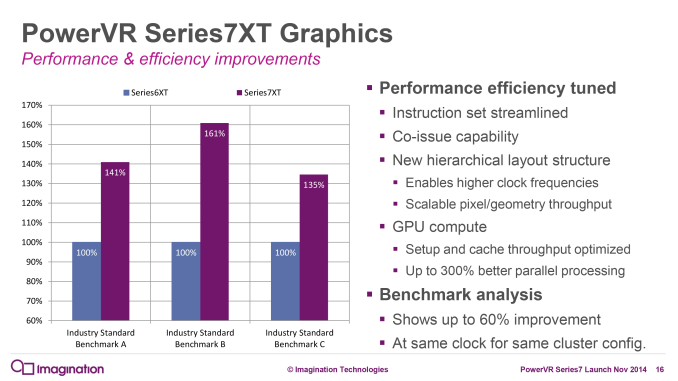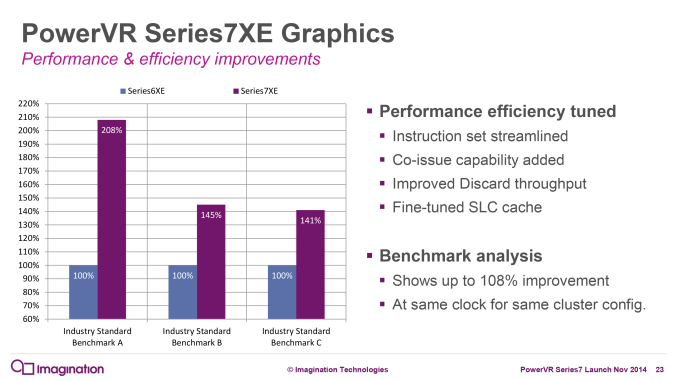Imagination Announces PowerVR Series7 GPUs - Series7XT & Series7XE
by Ryan Smith on November 10, 2014 8:50 AM EST- Posted in
- GPUs
- Mobile
- Imagination Technologies
- PowerVR
- PowerVR Series7
Performance Estimates
Wrapping things up, as Imagination is an IP licenser there isn’t any specific hardware to talk about or benchmark today, but Imagination has provided some performance estimates. As always these should be taken with a grain of salt, but until SoCs are released using the Series7 designs later next year, these are the best estimates we are going to see.
Ultimately the overall performance gains from 6XT to 7XT will depend on the application and the specific design goals of the SoC integrator, with Imagination’s internal data looking positive. At equal clockspeeds and cluster configurations, Imagination is showing performance gains of 30-60% for Series7XT. It should be noted that these numbers do not hold power consumption equal – higher utilization means transistors doing more work and burning energy more often – so real-world performance gains in power/heat limited scenarios would not be as great. But we are told to expect that at equal power levels performance should still be greatly improved over Series6XT, and even more over older Series6 devices.
Meanwhile from a performance perspective Imagination’s numbers paint 7XE as looking even better than 7XT on a relative gain basis. Once more holding core configurations and clockspeeds equal, performance is improved over 6XE by anywhere between 40% and 100%. No official explanation is provided for why 7XE benefits more than 7XT, but as 7XE has fewer USCs it also faces fewer bottlenecks from scaling, which can certainly be an advantage.
Closing Thoughts
All told, from top to bottom Series7 is designed to scale by a factor of 32; from ½ of a cluster up to 16 of them. With such a large range of configurations, Imagination is anticipating being able to cover the entire market with Series7, from wearable devices up to notebooks and even server compute clusters.
Meanwhile Imagination estimates that we should start seeing Series7 appear in retail roughly a year from now. This would be consistent with Series6XT/6XE, which were formally introduced at CES 2014 and hit the consumer market late in Q3 in devices such as the iPhone 6. We should see Series7 devices in roughly the same timeframe and consequently at this point it’s not unreasonable to expect Series7 to appear in Apple’s next SoC, judging from their history with Series6 and Series6XT.
With that said, it will be interesting to see how the SoC GPU market evolves over the next year leading up to Series7. Though very successful in supplying GPU IP to Apple, Imagination has been locked out of a number of potential Android devices due to Qualcomm’s strong position in that market and their own vertical integration. The launch of Android 5.0 “Lollipop” and its 64bit support serve as a potential catalyst for change in the Android hardware ecosystem, and while this is a battle that will initially be fought by Series6XT (as Cortex-A57 and A53 are already available), the transition time and the lead-in time required for SoC development means that Series7 will still play a big part in that.
Ultimately Series7 will be going up against stiff competition from a variety of competitors, so design wins will be hard-fought. In the GPU licensing space Imagination’s principle competition will be ARM and the recently-announced Mali 800 series (which will be available at roughly the same time). Meanwhile integrated SoC designers like Qualcomm and NVIDIA will also have competitive products such as the Adreno 400 series and Maxwell based Erista SoC respectively. So for 2015 as has been the case through 2013 and 2014, the SoC GPU space continues to be a busy and crowded market for Imagination, PowerVR Series7, and its competitors.













49 Comments
View All Comments
chizow - Monday, November 10, 2014 - link
Nvidia GPU SoC tech can be licensed, it just hasn't happened (yet).takeship - Tuesday, November 11, 2014 - link
Nvidia SoC tech can't be licensed. The terms they've put out are intentionally prohibitative. What the can do though, and have done, is legally claim to offer "licenses", and then sue all the market players when no one opts to spring for it and price themselves out of the market. Which is also what they've done.chizow - Wednesday, November 12, 2014 - link
And you know this how? I think the various lawsuits ongoing will be the impetus to establish the first licensees of Nvidia IP.hahmed330 - Monday, November 10, 2014 - link
In such a high end configuration why bother with FP16 Flops. It's a waste of die space. How relevant is FP16 in mobile configurations though nowadays? How huge is the quality degradation on a 7 inch screen?Ryan Smith - Monday, November 10, 2014 - link
"How relevant is FP16 in mobile configurations though nowadays?"Actually, very. FP16 is still significantly used because it can deliver the necessary quality at lower power. Games will tend towards FP32, but for desktop composition and such FP16 is more than plenty and is a task the GPU is frequently doing.
lefty2 - Tuesday, November 11, 2014 - link
When you use "lowp" in your shader it is using FP16. Shaders written for mobile games typically use lowp as much as possible, as it greatly increases performance, but desktop GPUs do not use them at all.coder111 - Monday, November 10, 2014 - link
Ok, so are they going to provide proper Linux drivers?http://en.wikipedia.org/wiki/Free_and_open-source_...
If not, they SUCK!
On the other hand, seeing mobile devices/tablets get similar level of GPU as dedicated consoles like PS3 and xbox360 is nice. Well, ok, ps3 and xbox360 are now 1 generation old, but still these are MOBILE GPUs.
GC2:CS - Monday, November 10, 2014 - link
"Though the first PowerVR Series 6XT-equipped products have only recently launched – including the unexpectedly powerful iPad Air 2..."You stole that from my mounth.... iPad Air 2 has an insanely fast GPU, they just kind of crushed it in that area.
The A8X matches the best nvidia offering at significally lower power with insane sustained performance.
And now you got an Series 7 GPU's... With rumors of Apple pushing heavilly for an 16nm Fin Fet Plus proces from TSMC which got some big power savings coupled with these GPU's... I think we will see that yearly doubling of GPU performance once more (and possibly last time, at least until we are stucked with silicone).
The question is, how big those are, with series 6XT we saw a 50% efficiency gain, but a far bigger GPU size as well. As TSMC 16FF+ is not that much of a shrink at all it could be a problem going with an even bigger architecture.... Even then an A9 and A9X build on a mature 20nm process with GT7400/7600 and somewhat higher clock speeds could bring some prety big improvements as well.
Then there is nvidia, can Apple defeat them like this year ?
Or will nvidia finaly show what they can do for mobile ?
pSupaNova - Monday, November 10, 2014 - link
I think you have it the wrong way round.Nvidia has the more powerful CPU core uses less transistors and was running on a worse process.
While if you bothered to read this article has implemented more functions in its GPU Tessellation, DirectX 11, OpenGL 4.4 & Android Extension Pack.
Anandtech has the K1 tabs beating the IPad Air in the GPU tests.
http://www.anandtech.com/show/8670/google-nexus-9-...
lucam - Monday, November 10, 2014 - link
Really? It seems (from preliminary results) the Nexus 9 is behind, although the difference is negligible.We must have different interpretations of numbers and words...